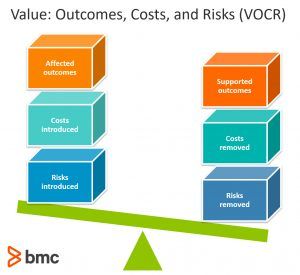At the heart of ITIL® is Service Management. Whether you provide sports gear or pedicures, the reason your organizations exists is to deliver quality services that:
- Enable the customer to achieve their goals
- Provide value for money for the organization
Service management is a set of specialized organizational capabilities for enabling value for customers in the form of services. These capabilities include tangible things like capital, people, and equipment, and can also include intangible things like knowledge, management and skills. These capabilities can also include intangible things, like knowledge, management, and skills.
The goal of IT service management is to maximize the value delivered and obtained from technology-driven products and services. To succeed at service management, these concepts are crucial:
- Value co-creation
- Stakeholders in service management
- Service relationships
- Products & services
- Value: Outcomes, Costs & Risks
- Utility & warranty
Let’s take a look. (This article is part of our ITIL 4 Guide. Use the right-hand menu to navigate.)
Download Now: ITIL 4 Best Practice e-Books
These all-new for 2020 ITIL e-books highlight important elements of ITIL 4 best practices. Quickly understand key changes and actionable concepts, written by ITIL 4 contributors.
Value Co-Creation
The purpose of an organization is to create value for stakeholders. Here, value is defined as:
- Perceived benefits
- Usefulness
- Importance
Value is subject to the perception of the stakeholders, whether they be the customers or consumers or the organization itself. Think about a ride sharing service: for some people the value is convenience; for others it might be cost or flexibility. Value can be subjective, depending on the point of view.
In the past, organizations viewed themselves as ‘service providers’, delivering value to their customers in a mono-directional manner: the provider delivering value to the customer, while the customer plays no role in value creation. This model, however, has become outdated.
Organizations now recognize that value is co-created through an active collaboration between providers and consumers. This co-creation is augmented by the work of other stakeholders which are part of the relevant service relationships.
Stakeholders in Service Management
This new perspective of value co-creation results in a critical need to identify all the players who are involved. This could include suppliers, consumers, financiers, regulators—even influencers. Let’s identify some of the main stakeholders in service management:
| Stakeholder | Definition | Example |
| Organization | A person or a group of people that has its own functions with responsibilities, authorities, and relationships to achieve its objectives. | A company, an institution, or an individual |
| Service Provider | An organization that takes up the role of creating and delivering services | An airline that provides air transportation services |
| Service Consumers | An organization that takes up the role of receiving services | A business that buys and uses internet services from an ISP |
The term service consumer is generic by nature, so we can further delineate roles such as:
- Customer: A person who defines the requirements for a service and takes responsibility for the outcomes of service consumption; e.g., the IT Manager.
- User: A person who uses services; e.g. the company employees.
- Sponsor: A person who authorizes budget for service consumption; e.g., the Finance Manager.
Note that these terms can be used by a single individual who can act as the customer, user, and sponsor of a service they have bought and consumed.
Beyond the consumer and provider roles, many other stakeholders are often important to value creation. Identifying these roles in service relationships ensures effective communication and stakeholder management.
Service Relationships
A service relationship is defined as the cooperation between a service provider and service consumer. Service relationships are established between two or more organizations to co-create value. An organization can play the role of provider or consumer interchangeably, depending on the situation.
Service relationships include:
- Service provision
- Service consumption
- Service relationship management, which are the joint activities performed by a service provider and a service consumer to ensure continual value co-creation based on agreed and available service offerings.
The service relationship model is used to showcase the ever-changing interaction between service providers and consumers. An organization can procure services and use them to deliver services to another consumer, thus shifting from consumer to provider. For example, a call centre may purchase internet services from a supplier and then use those services to provide customer relationship management services for its customers.
Products & Services
In ITIL, the service is the ultimate center of focus in every aspect of service management. A service is defined as a means of enabling value co-creation by facilitating outcomes that customers want to achieve, without the customer having to manage specific costs and risks. The services that an organization provides are based on one or more of its products.
A product is any configuration of an organization’s resources designed to offer value for a consumer. Resources can include people, capital, equipment, software, etc.
Service providers usually present their services to consumers in the form of service offerings, which describe one or more services based on one or more products. A service offering is a description of one or more services that are designed to address the needs of a target consumer group. The three main components of service offerings are:
- Goods
- Access to resources
- Service actions
Here are some examples:
| Component | Description | Examples |
| Goods | Supplied to the consumer Ownership is transferred to the consumer Consumer takes responsibility for future use | Appliances Consumer goods
|
| Access to Resources | Ownership is not transferred to the consumer Access is granted or licensed to the consumer under agreed terms and conditions The consumer can only access the resources during the agreed consumption period and according to other agreed service terms | Web hosting Cloud Storage Online gaming subscription |
| Service Actions | Performed by the service provider to address a consumer’s needs Performed according to an agreement with the consumer | Car maintenance IT user support |
Different offerings can be configured for different target consumer segments depending on:
- Demand
- Capacity to pay
- Additional factors/span>
Value: Outcomes, Costs & Risks (VOCR)
Service providers help their consumers to achieve outcomes and, in doing so, take on some of the associated risks and costs. However, the service relationship can result in negative outcomes or introduce new or previously unknown risks and costs.
Service relationships are perceived as valuable only when they have more positive effects than negative, particularly regarding impact on outcomes, costs, and risks.

Value as a function of outcomes, costs, and risks
Outcomes
When an organization acts as a service provider, it produces outputs that help its consumers to achieve certain outcomes. An output is defined as a tangible or intangible deliverable of an activity; for example, transportation from one location to another.
An outcome, by contrast, is the result for a stakeholder that was enabled by one or more outputs. If the output is transportation between locations, the outcome might be that the stakeholder has an interview or doctor’s appointment.
Depending on the relationship between the provider and the consumer, it can be difficult for the provider to fully understand the outcomes that the consumer wants to achieve. In some cases, both parties will work together to define the desired outcomes.
Costs
Costs are the amount of money spent on a specific activity or resource. From the service consumer’s perspective, there are two types of cost involved in service relationships:
- Costs removed from the consumer by the service (a part of the value proposition). For example, for a car sharing service, the customer does not pay for the actual cost of purchasing the car.
- Costs imposed on the consumer by the service (the costs of service consumption). In a car sharing service, the customer pays for cellular or internet services to request the service.
The two types of cost must be fully understood if a service provider is to obtain value for money and ensure the right decisions are made about the service provision. Providers need to ensure that services are delivered within budget constraints and meet the financial expectations of the organization.
Risks
A risk is any event, including possible events, that could cause harm or loss or make it more difficult to achieve objectives. Risk is considered an uncertain outcome, one that that can be positive or negative. Two types of risk are concerning to service consumers:
- Risks removed from a consumer by the service (part of the value proposition). For example, for an online streaming service, the failure of equipment involved in delivering the service.
- Risks imposed on a consumer by the service (risks of service consumption). For an online streaming service, the threat of lawsuit for copyright infringement.
It is the duty of the provider to manage the detailed level of risk on behalf of the consumer. However, the consumer has a role to play in contributing to risk reduction as a function of value co-creation. The consumer contributes to reducing risk by:
- Actively participating in defining the service requirements and clarifying its required outcomes, often on an ongoing basis.
- Clearly communicating the critical success factors (CSFs) and constraints that apply to the service.
- Ensuring the provider has access to the necessary consumer resources throughout the service relationship.
Utility & Warranty
How do we know that a service is delivering value for the consumer and meeting the service provider’s requirements? By evaluating, in totality, the utility and warranty of the service.
- Utility is the functionality offered by a product or service to meet a particular need. Utility perhaps answers ‘what the service does’ or whether a service is ‘fit for purpose’. To have utility, a service must either support the performance of the consumer and/or remove constraints from the consumer.
- Warranty, on the other hand, is the assurance that a product or service will meet agreed requirements. Warranty answers ‘how the service performs’ or whether a service is ‘fit for use’. Warranty often relates to service levels aligned with the needs of service consumers, such as availability, capacity, security, and continuity.
When assessing a service, you must consider the impact of costs and risks on utility and warranty—this generates a complete picture of the viability of a service. Both utility and warranty are essential for a service to facilitate its desired outcomes and, therefore, help create value. For example, if you are using a courier delivery service, the utility involves the delivery of your packages while warranty is about the speed and handling of your packages.
ITIL® is a registered trade mark of AXELOS Limited. IT Infrastructure Library® is a registered trade mark of AXELOS Limited.







